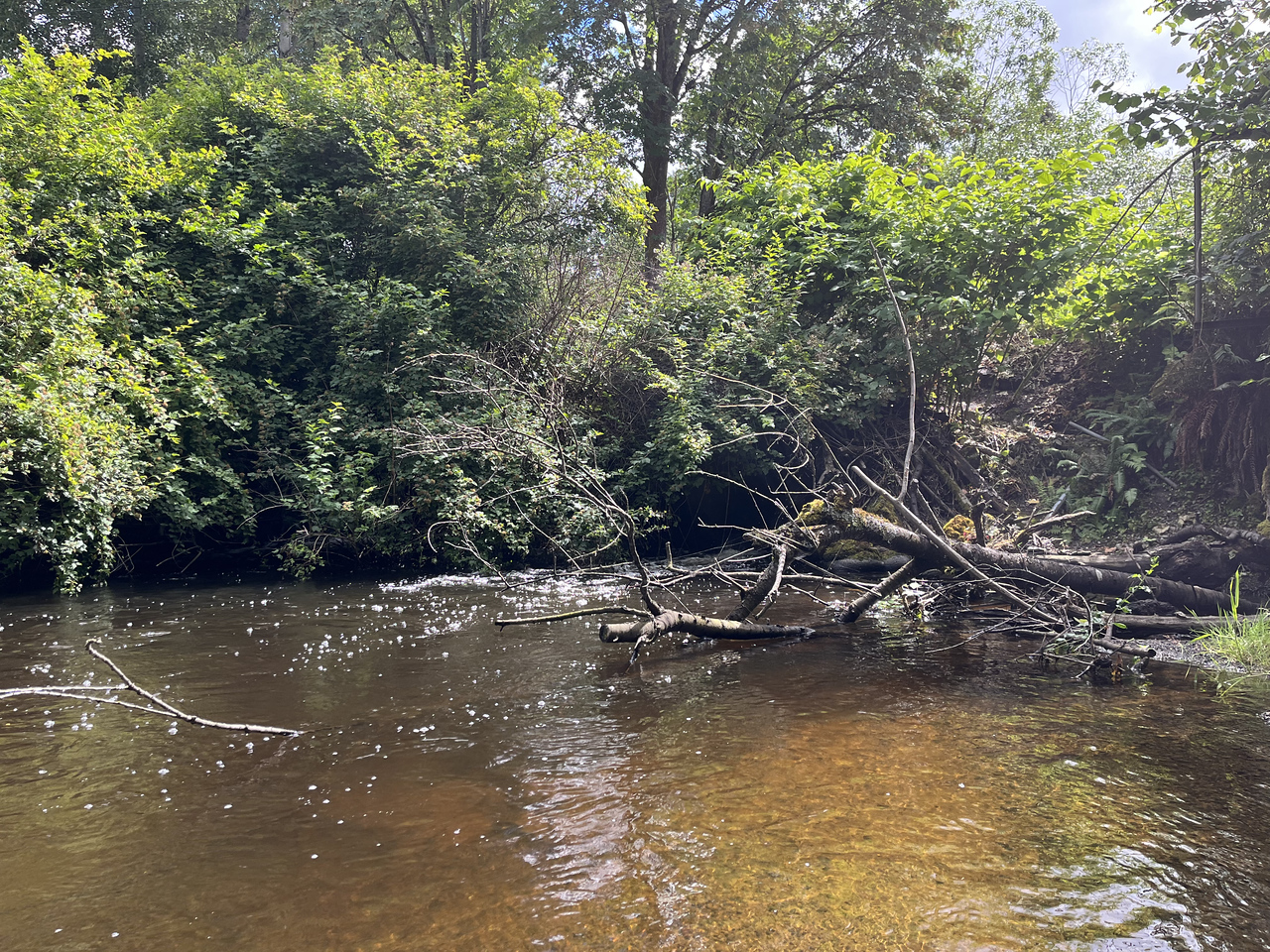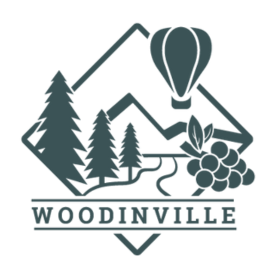134th Ave Culvert Replacement
Project Overview
At the intersection of environmental recovery and modern infrastructure, Woodinville is launching a transformational project that reconnects Little Bear Creek, safeguards the community from flooding, and bridges the community.
The 134th Avenue NE Culvert Removal and Bridge Replacement Project will eliminate a known fish passage barrier by removing three undersized culverts beneath the roadway and replacing them with a 30-foot recycled railroad trestle, creating a single-span bridge that restores the creek’s natural function.
Rooted in conservation, the project will restore nearly two miles of salmon habitat, improve city infrastructure, and deliver a smarter, more sustainable solution by reusing materials from the nearby SR 202 Corridor Widening and Trestle Replacement Project. By combining two infrastructure efforts, the City is reducing costs, streamlining construction, and minimizing long-term disruption to the community.
Key Benefits
- Restores fish passage: Removes culverts identified as barriers by the Washington Department of Fish and Wildlife, enabling native salmon and trout to reach critical habitat.
- Reconnects vital habitat: Opens over two miles of upstream spawning and rearing areas for Chinook, Coho, Sockeye, Steelhead, Cutthroat, and resident trout species.
- Improves stream function: Replaces perched culverts with a natural streambed and open-span design, restoring sediment movement and aquatic passage.
- Supports climate goals: Reuses a railroad trestle from the SR 202 corridor project—reducing new material use, emissions, and construction waste.
- Protects people and property: Removes culverts that cannot handle 100-year flood events, reducing flood risks to roads, businesses, and utilities.
- Improves infrastructure access: Maintains critical service access for businesses, City property, and utility companies.
- Strengthens community resilience: Enhances the City's ability to adapt to more frequent and severe storms tied to climate change.
- Delivers cost-effective design: Combines two City projects for streamlined delivery, coordinated permitting, and reduced public disruption.
Why It Matters: Reconnecting a Salmon Habitat
Little Bear Creek’s Role in the Ecosystem
Little Bear Creek is a vital ecological corridor that supports a diverse range of native salmon and trout species. Among them are Puget Sound Chinook and Puget Sound Steelhead, both listed as threatened under the Endangered Species Act (ESA). The creek also provides habitat for Coho, Sockeye, Kokanee, and Coastal Cutthroat trout, all of which play essential roles in the health of the watershed. These fish are woven into the cultural traditions of Tribal nations, the ecological balance of local streams, and the economic identity of the region. They also serve as a critical food source for the endangered Southern Resident Orcas, linking the health of inland waterways like Little Bear to the survival of one of the Pacific Northwest’s iconic species.
This stretch of creek flows downstream into the Sammamish River, then continues through Lake Washington and Lake Union. From there, it passes through the Ballard Locks and enters Puget Sound at Salmon Bay, just minutes north of downtown Seattle, WA. This connection links Woodinville’s upper watershed to one of the most significant salmon migration routes in the Pacific Northwest.
But decades of development and culvert installation have fragmented this habitat. At 134th Avenue NE, three 60-inch culverts currently block fish passage, altering natural stream flow and disconnecting vital habitat. These culverts are now the one of the lowest remaining fish barriers on Little Bear Creek, making their removal a top priority under the WRIA 8 Chinook Salmon Conservation Plan.
The Science Behind the Urgency
Surveys of the creek historically recorded up to 62 adult Chinook and over 460 Coho during the 1980s. By 2001, Chinook salmon had disappeared from the stream entirely. Coho and Kokanee remain present, but population numbers are significantly reduced.
Species found in Little Bear Creek include:
- Puget Sound Chinook (ESA-listed)
- Puget Sound Steelhead (ESA-listed)
- Coho, Sockeye, and Kokanee salmon
- Resident Cutthroat and Rainbow trout
- Western brook lamprey
- Coastrange sculpin
Restoring fish passage at this location will reconnect spawning and rearing habitats and support the rebound of multiple fish populations that depend on access to cool, shaded, upper reaches of the stream for survival.
Project Background & Vision
A Decade of Planning, Projects, and Partnership
With a culmination of more than 15 years of focused restoration, technical analysis, and partnership building, this project is the result of a shared vision to restore fish passage in Little Bear Creek and protect Woodinville’s infrastructure for future generations.
In the early 2000s, the City identified Little Bear Creek as a priority for environmental restoration as part of broader salmon recovery efforts in the Puget Sound region. In 2012, the City removed undersized culverts at 132nd Avenue NE as the first effort to restore fish passage to Little Bear Creek. In 2017, WSDOT replaced a fish passage barrier under SR 202 with bridge, further restoring the stream channel. With several downstream barriers removed, the culverts at 134th Avenue NE became the next obstacle to address.
During early planning for the SR 202 Widening and Trestle Replacement Project, a new idea emerged: what if the removed trestle could be repurposed to span Little Bear Creek? This innovation became a cornerstone of the vision, turning what might have been a straightforward utility project into a model of sustainable engineering and salmon-friendly design.
Over the years, the City worked hand-in-hand with a wide network of regional partners and stakeholders who helped shape the project from concept to implementation. These relationships were instrumental in developing restoration goals, coordinating design work, and securing funding.
Partner Agencies and Organizations:
- Washington Department of Fish and Wildlife
- U.S. Army Corps of Engineers
- Muckleshoot Indian Tribe
- Adopt A Stream Foundation
- Mountains to Sound Greenway Trust
- Woodinville Water District
The project also aligns with the City’s obligations under its 2023 Stormwater Management Action Plan (SMAP), a requirement of the Western Washington Phase II Municipal Stormwater Permit. Through this plan, Little Bear Creek was identified as a priority watershed, reinforcing the importance of this restoration as both a local and regional commitment.
These milestones, relationships, and innovations have positioned the 134th Avenue NE Bridge Project to deliver benefits far beyond its footprint—reconnecting habitat, preventing flood damage, and fulfilling Woodinville’s promise to lead on climate resilience, environmental justice, and infrastructure sustainability.
A Bridge with Purpose: Innovation Through Reuse
In an innovative step toward sustainability, the City is planning to reuse a portion of the railroad trestle removed during the SR 202 Corridor Widening Project. Instead of discarding the old structure, it will be retrofitted and relocated to 134th Avenue NE.
Benefits of Reusing the SR 202 Trestle:
- Reduces construction costs by repurposing an existing structure rather than fabricating a new one
- Minimizes material waste by diverting large-scale steel and concrete components from landfills
- Accelerates construction timelines by reducing the lead time required for custom bridge components
- Lowers carbon emissions by avoiding new steel production and long-distance transport
The trestle’s reuse is a case study in doing more with less: less disruption, less material waste, and less financial burden.
Why Remove the Culverts?
Resilience, Risk, and Recovery
The culverts at 134th Avenue NE are ecological barriers and outdated infrastructure with known safety and hydraulic risks. A series of hydraulic studies beginning in 2008 found that these culverts:
- Cannot safely pass a 100-year flood event
- Are perched above the streambed, preventing fish movement
- Trap debris, increasing flood and erosion risk downstream
By replacing these culverts with an open-span bridge, the City will restore the natural stream profile, increase habitat continuity for fish populations, including Chinook salmon, reduce flood risk, and protect downstream properties, roads, and utilities. Removal of the culverts will improve hydrologic function, reduce backwater effects, and help mitigate future flooding.
Facing Climate Change Head-On
Extreme weather is becoming more common in our region—more rain, longer storms, higher peak flows. This project helps the community adapt by:
- Improving drainage and storm resilience in a flood-prone corridor
- Reconnecting floodplain terraces and reducing erosive pressure
- Planting native trees and shrubs to increase shading and slow runoff
- Creating long-term habitat buffers that also sequester carbon
This stretch of Little Bear Creek will become not only more fish-friendly—but more community-friendly, too.
What’s Next?
The City is advancing toward construction with design and permitting underway. Once complete, the project team will prepare construction bid materials.
As timelines progress, the City will continue to share updates with the public through events, signage, newsletters, and this project webpage. Major milestones will also be brought to City Council for review.
Stay Informed
The City is committed to keeping the community engaged and informed. Here’s how you can stay connected:
- Check this webpage for regular updates
- Subscribe to City newsletters and alerts
- Attend public events or open houses
- Look for on-site signage and announcements as construction nears
This project represents not just an infrastructure improvement, but a lasting investment in salmon recovery, climate resilience, public safety, and the environmental legacy of our community.


